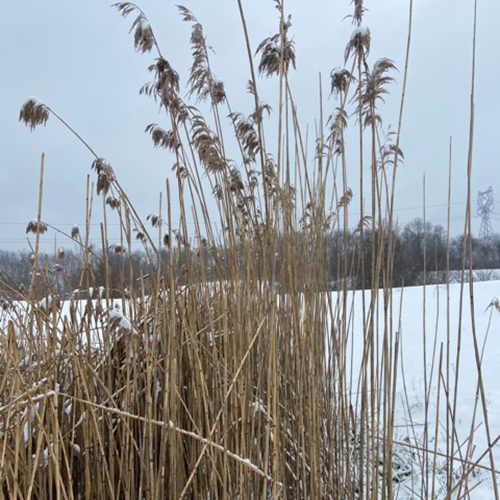Phragmites Common Reed (invasive species)
Phragmites, phragmites australis, forms dense stands with green grass like leaves. Phragmites can grow 6 to 20 feet tall. At the top of the stalk is a feathery tassel similar to the top of a corn stalk.
Spreading occurs through seed and rhizomes. Plants produce roughly 2,000 seeds each season. The rhizomes can grow down 6 feet into soil allowing them to survive in a wide range of conditions. Another name for invasive phragmites is common reed.
Native phragmites (phragmites americanus) is not classified as an invasive aquatic plant. Key differences are shorter stalks (6 feet), and typically growth amongst other vegetation. Non-native phragmites australis is significantly taller and forms dense growth leaving no room for other plant species to thrive.

How does phragmites spread?
Wind is the primary source of phragmites vast growth. The seeds are dispersed by wind and produce new growth in spring.
Phragmites life cycle
In early spring phragmites germinates. Germination is the process of a seed coming out of dormancy and begin to develop into a plant.
Early to mid summer is when the majority of the plant growth occurs. In mid summer the seed head (feathery tassel) appears. Seed shedding occurs in fall. A period of dormancy occurs in late fall and continues through winter months
Where do phragmites grow?
It can be found in areas with moist soil, along ponds, lakes, and wetlands. Vegetation can grow in 2 feet of water depth but can also tolerate dry conditions due to the rhizome's deep penetration into the soil.
Why are Phragmites Invasive?
Phragmites are invasive because they reduce habitat for fish and wildlife. They block out desired plant species that provide benefit to aquatic life.
There are limited benefits to aquatic life. Phragmites outcompetes desired plant species. The extreme height causes visibility issues.
Phragmites produces more waste than shorter shoreline weeds which causes shorelines depths to decrease at a faster rate. While these reeds produce growth up to 20 feet tall, 80 percent of the total organic waste is actually below the surface in the root system.
How to get rid of phragmites
Cattail Killer Pack is the best treatment option to control phragmites. This treatment is tank mixed and sprayed directly on leaves and seed flowers. Herbicide only kills weeds that it comes in contact with. Dense stands of phragmites require multiple treatments.
Once an aquatic herbicide is used, vegetation can cleared mechanically or through a prescribed fire. Do NOT remove vegetation until at least 2 weeks after herbicide application to ensure the chemical uptake into the plant has occurred.
This reduces the amount of new biomass (organic waste from dead vegetation). This also clears the ground for new beneficial vegetation to establish and thrive.
Glyphosate 5.4 is a liquid aquatic herbicide that will work on phragmites. Spray glyphosate mixed with Aquatistick directly on weeds to kill vegetation to the roots. Mix with Cattzilla for accelerated breakdown period.
When is the best time to spray phragmites?
For best results, apply aquatic herbicide when the weed is in full bloom (seed plume is present).
Phragmites Control
Need help identifying your POND WEED or How Much Treatment To Use?
Click Here To Submit Your Pond Help Request
